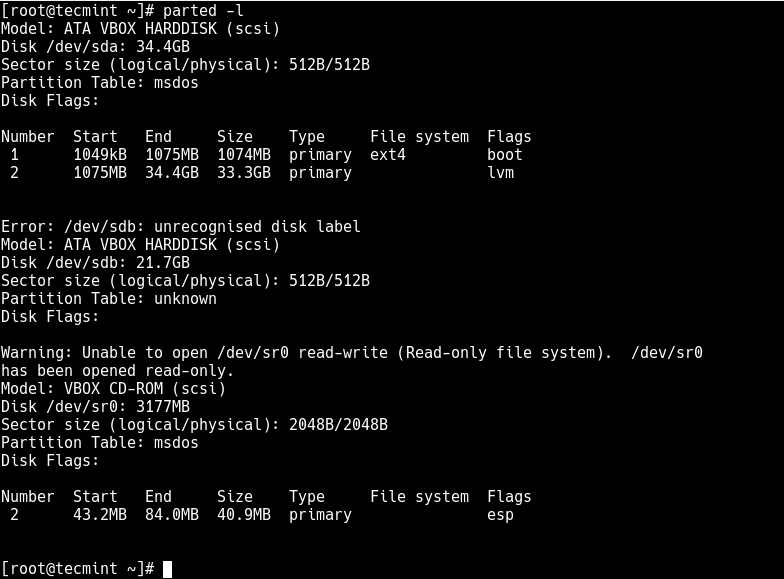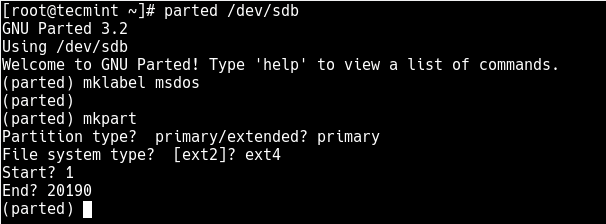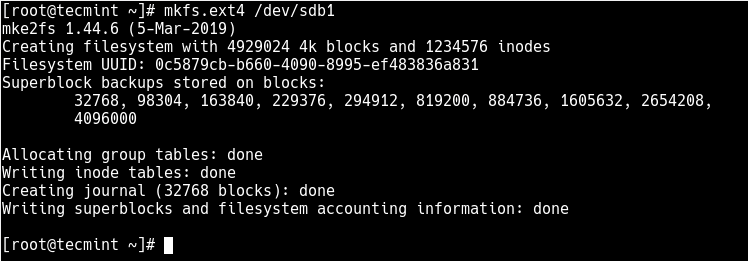- How to Create a New Ext4 File System in Linux?
- Available Filesystem types
- Look at the Current Partitions
- Adding a new partition
- Как создать новую файловую систему Ext4 (раздел) в Linux
- Создание нового раздела в Linux
- Форматирование нового раздела Ext4
- Монтирование нового раздела Ext4 в файловой системе
- How to Create a New Ext4 File System (Partition) in Linux
- Creating a New Partition in Linux
- Formatting New Ext4 Partition
- Mounting New Ext4 Parition in File System
- Related Posts
- 13 thoughts on “How to Create a New Ext4 File System (Partition) in Linux”
How to Create a New Ext4 File System in Linux?
The hard disk in a computer is formatted with specific file system so that the operating system can read and write into it. For UNIX based systems we have various type of file systems. In this article we will see how to format a new partition in hard disk with ext4 file system.
Available Filesystem types
First we see what are the different file systems available for the current operating system. The below command lists all those file systems.
Running the above code gives us the following result −
/sbin/mkfs /sbin/mkfs.bfs /sbin/mkfs.cramfs /sbin/mkfs.ext2 /sbin/mkfs.ext3 /sbin/mkfs.ext4 /sbin/mkfs.ext4dev /sbin/mkfs.fat /sbin/mkfs.minix /sbin/mkfs.msdos /sbin/mkfs.ntfs /sbin/mkfs.vfat
Look at the Current Partitions
Next let’s look at the the current hard disk and their partitions available to the operating system. Based on this output we can decide to add a new hard disk or create a new partition in the existing desk and format it as ext4.
$ sudo fdisk -l [sudo] password for ubuntu:
Running the above code gives us the following result −
Disk /dev/sda: 20 GiB, 21474836480 bytes, 41943040 sectors Units: sectors of 1 * 512 = 512 bytes Sector size (logical/physical): 512 bytes / 512 bytes I/O size (minimum/optimal): 512 bytes / 512 bytes Disklabel type: dos Disk identifier: 0x06807e05 Device Boot Start End Sectors Size Id Type /dev/sda1 * 2048 33554431 33552384 16G 83 Linux /dev/sda2 33556478 41940991 8384514 4G 5 Extended /dev/sda5 33556480 41940991 8384512 4G 82 Linux swap / Solaris
Adding a new partition
Using the same command but choosing a different argument as shown below. We see all the available formats that the OS can support and available for formatting.
$ sudo fdisk /dev/sda Command (m for help): l
Running the above code gives us the following result −
0 Empty 24 NEC DOS 81 Minix / old Lin bf Solaris 1 FAT12 27 Hidden NTFS Win 82 Linux swap / So c1 DRDOS/sec (FAT- 2 XENIX root 39 Plan 9 83 Linux c4 DRDOS/sec (FAT- 3 XENIX usr 3c PartitionMagic 84 OS/2 hidden or c6 DRDOS/sec (FAT- 4 FAT16Next we choose the n option to create a new partition.
Command (m for help): n Command action l logical (5 or over) p primary partition (1-4) First sector (39849982-41940991, default 39849982): Using default value 39849982 Last sector, +sectors or +stze(K,M,G> (39849982-41940991, default 4 1940991): Using default value 41940991Now we issue the below command to make the sda5 partiton as a ext4 partition.
Как создать новую файловую систему Ext4 (раздел) в Linux
ext4 или четвертая расширенная файловая система — это широко используемая файловая система журналирования для Linux. Он был разработан как прогрессивная версия файловой системы ext3 и преодолевает ряд ограничений ext3.
Он имеет значительные преимущества по сравнению со своим предшественником, такие как улучшенный дизайн, более высокая производительность, надежность и новые функции. Хотя он лучше всего подходит для жестких дисков, его также можно использовать на съемных устройствах.
Эта статья покажет вам, как создать новую файловую систему ext4 (раздел) в Linux. Мы в первую очередь рассмотрим, как создать новый раздел в Linux, отформатировать его в файловой системе ext4 и смонтировать.
Примечание. Для целей этой статьи:
- Мы предполагаем, что вы добавили новый жесткий диск на свой Linux-компьютер, на котором вы создадите новый раздел ext4, и
- Если вы работаете в системе от имени администратора, используйте команду sudo, чтобы получить привилегии суперпользователя и выполнять команды, показанные в этой статье.
Создание нового раздела в Linux
Перечислите разделы, используя команды parted -l, чтобы определить жесткий диск, который вы хотите разбить.
Глядя на вывод на снимке экрана выше, мы добавили два жестких диска в тестовую систему, и мы разделим диск /dev/sdb .
Теперь используйте команду parted, чтобы начать создание раздела на выбранном устройстве хранения.
Теперь дайте команду mklabel.
Затем создайте раздел с помощью команды mkpart, задайте ему дополнительные параметры, такие как «основной» или «логический», в зависимости от типа раздела, который вы хотите создавать. Затем выберите ext4 в качестве типа файловой системы, установите начало и конец, чтобы установить размер раздела:
(parted) mkpart Partition type? primary/extended? primary File system type? [ext2]? ext4 Start? 1 End? 20190
Чтобы распечатать таблицу разделов на устройстве /dev/sdb или подробную информацию о новом разделе, выполните команду печати.
Теперь выйдите из программы с помощью команды quit.
Форматирование нового раздела Ext4
Затем вам необходимо правильно отформатировать новый раздел с типом файловой системы ext4 с помощью mkfs.ext4 или команды mke4fs следующим образом.
# mkfs.ext4 /dev/sdb1 OR # mke4fs -t ext4 /dev/sdb1
Затем пометьте раздел с помощью команды e4label следующим образом.
# e4label /dev/sdb1 disk2-part1 OR # e2label /dev/sdb1 disk2-part1
Монтирование нового раздела Ext4 в файловой системе
Затем создайте точку монтирования и смонтируйте только что созданную файловую систему раздела ext4.
# mkdir /mnt/disk2-part1 # mount /dev/sdb1 //mnt/disk2-part1
Теперь, используя команду df, вы можете перечислить все файловые системы в вашей системе вместе с их размерами в удобочитаемом формате (-h) , а также их точки монтирования и типы файловых систем (-T ) :
Наконец, добавьте следующую запись в свой /etc/fstab, чтобы разрешить постоянное монтирование файловой системы даже после перезагрузки.
/dev/sdb1 /mnt/disk2-part1 ext4 defaults 0 0
Вы также можете прочитать следующие статьи по теме:
- Как добавить новые диски с помощью LVM в существующую систему Linux
- Как добавить новый диск к существующему серверу Linux
- 10 лучших инструментов шифрования файлов и дисков для Linux
- Как создать том виртуального жесткого диска с помощью файла в Linux
Вот и все! В этой статье мы объяснили, как создать новый раздел в Linux, отформатировать его с файловой системой ext4 и смонтировать как файловую систему. Для получения дополнительной информации или для того, чтобы поделиться с нами любыми вопросами, используйте форму обратной связи ниже.
How to Create a New Ext4 File System (Partition) in Linux
The ext4 or fourth extended filesystem is a widely-used journaling file system for Linux. It was designed as a progressive revision of the ext3 file system and overcomes a number of limitations in ext3.
It has significant advantages over its predecessor such as improved design, better performance, reliability, and new features. Although it is best suited for hard drives, it can also be used on removable devices.
This article will show you how to create a new ext4 file system (partition) in Linux. We will first of all look at how to create a new partition in Linux, format it with the ext4 file system and mount it.
Note: For the purpose of this article:
- We will assume that you have added a new hard drive to your Linux machine, in which you will create the new ext4 partition, and
- If you are operating the system as an administrative user, use the sudo command to gain root privileges to run the commands shown in this article.
Creating a New Partition in Linux
List the partitions using the fdisk -l or parted -l commands to identify the hard drive you want to partition.
Looking at the output in the screenshot above, we have two hard disks added on the test system and we will partition disk /dev/sdb .
Now use parted command to start creating the partition on the selected storage device.
Then create a partition using the mkpart command, give it additional parameters like “primary” or “logical” depending on the partition type that you wish to create. Then select ext4 as the file system type, set the start and end to establish the size of the partition:
(parted) mkpart Partition type? primary/extended? primary File system type? [ext2]? ext4 Start? 1 End? 20190
To print the partition table on the device /dev/sdb or detailed information about the new partition, run the print command.
Now exit the program using the quit command.
Formatting New Ext4 Partition
Next, you need to properly format the new partition with the ext4 file system type using the mkfs.ext4 or mke4fs command as follows.
# mkfs.ext4 /dev/sdb1 OR # mke4fs -t ext4 /dev/sdb1
Then label the partition using the e4label command as follows.
# e4label /dev/sdb1 disk2-part1 OR # e2label /dev/sdb1 disk2-part1
Mounting New Ext4 Parition in File System
Next, create a mount point and mount the newly created ext4 partition file system.
# mkdir /mnt/disk2-part1 # mount /dev/sdb1 //mnt/disk2-part1
Now using the df command, you can list all file systems on your system together with their sizes in a human readable format (-h) , and their mount points and file system types (-T) :
Lastly, add the following entry in your /etc/fstab to enable persistent mounting of the file system, even after a reboot.
/dev/sdb1 /mnt/disk2-part1 ext4 defaults 0 0
You might also like to read these following related articles:
That’s all! In this article, we’ve explained how to create a new partition in Linux, format it with ext4 file system type and mount it as a filesystem. For more information or to share any queries with us, use the feedback form below.
I am an experienced GNU/Linux expert and a full-stack software developer with over a decade in the field of Linux and Open Source technologies
Each tutorial at TecMint is created by a team of experienced Linux system administrators so that it meets our high-quality standards.
Related Posts
13 thoughts on “How to Create a New Ext4 File System (Partition) in Linux”
Hello, I don’t know how Ravi Saive found out the size of the partition, but I’ve found you can use percent to size the partition (you can reply 100% to the question End? and it uses the whole free space available) Reply
Another thing that is missing is what sector size should be considered (physical or logical). In this example, it did not matter because both were the same. However, in my case the two are not the same. Which to choose? I would think that it is the logical sector size, but if we are dealing with /dev/sda (in my case), perhaps this indicates the use of the physical sector size. Reply
This would be a wonderful tutorial if I knew how you got the size for the new partition. It seems that you pulled the number 20190 out of thin air! How do I get the right number if I want to use the whole disk? Reply
0% and 100% as start and end work. Looks like the author copied some really old instructions. mklabel gpt should be your go-to today, otherwise, you will get errors with disks over 2.5ishTB Reply
Thanks for this article. Is there a way of renaming /mnt/disk2-part1 to something else than “disk2-part1“? Reply
# e2abel /dev/sdb1 disk2-part1
I prefer to use GParted to do my disk manipulations. With GParted I do not need to learn and remember cryptic, unintuitive commands. With a GUI application, there is much less chance of using the wrong option or misspelling a command and completely wiping out the entire disk. Reply
People for whom these instructions would be beneficial do not use servers. OTOH, people who use or deal with servers have this procedure memorized. Judging by the questions and comments so far, it seems that the posters have very little idea of what is being done. By using a GUI tool like GParted, they would SEE what is happening with the disk they are trying to partition rather than having to imagine it. I am all for using CLI but when it is actually an improvement on GUI. This is 2021 and, in the 30 years of Linux’s existence, many CLI procedures have been released as GUI tools. For some reason, Linux tech writers are pushing the command line as if it was The Greatest Thing Since Sliced Bread. Sure, CLI may be l33t but it certainly IS NOT inviting and encouraging to new Linux users. How many articles are there extolling the virtues of MS-DOS or even the current Windows command line? Reply















